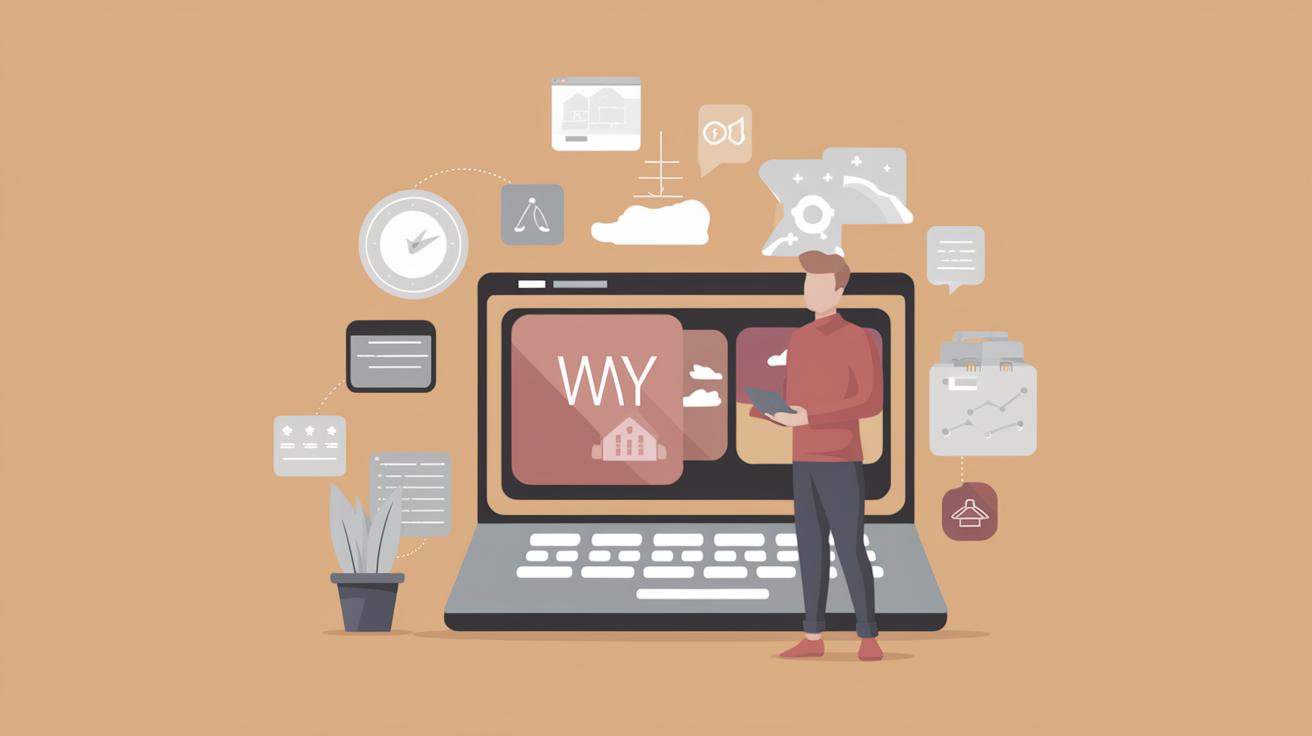How to Make a Desktop Application
Crafting a desktop application offers an exciting opportunity to bring innovative ideas to life while reaching a wide audience. This blog post guides you through the essentials of desktop application development, covering foundational knowledge, tool selection, user interfaces, architecture, and security considerations. Explore the workflow of creating a desktop app, from planning to deployment, and learn about real-world examples that highlight successful applications. Whether you aim to build a simple “Hello World” program or a robust, cross-platform application, this guide offers valuable insights for all aspiring developers.
Let’s do a “Hello World”
Starting with a “Hello World” application is an excellent way to dip your toes into the world of desktop application development. This simple program allows developers to familiarize themselves with the basic setup of development environments, programming languages, and the workflow of building an executable application. The simplicity of “Hello World” makes it a perfect starting point for beginners and serves as a stepping stone to more complex projects.
Often, developers create the “Hello World” application to verify their development environment is set up correctly. It typically involves writing a few lines of code in a chosen programming language, compiling the code, and running the application to display “Hello World” on the screen. Although seemingly small, this exercise is crucial in testing and solidifying the technical setup needed for more advanced applications.
Use Real Time
Utilizing real-time data and functionalities in desktop applications can significantly enhance user engagement and application utility. Real-time capabilities allow applications to push and pull data continuously, providing users with up-to-date information and interactive experiences. Whether integrating live feeds, chat functionality, or dynamic content updates, real-time applications can dramatically improve user satisfaction and retention.
Incorporating real-time features requires careful consideration of data management and networking protocols. Developers must choose appropriate technologies and frameworks that support robust real-time data transfer, aiming to balance performance and resource use. By effectively integrating real-time functionalities, developers can elevate their applications to a new level of interactivity and efficiency.
Key Takeaways
The journey of developing a desktop application involves meticulous planning, proper tool selection, and a focus on user experience. It’s crucial to understand the benefits of building performant, secure, and maintainable applications while leveraging the right frameworks and architectures. Cross-platform development is an advantageous strategy in today’s multi-device world, offering wider reach and cost efficiency.
Through the presented steps—from foundational “Hello World” applications to real-time integration—we see a comprehensive approach to desktop application development. By focusing on these key aspects, developers can create compelling applications that not only serve their intended purpose but also bring significant value to users and stakeholders alike.
Diving into Desktop App Creation
Selecting the Right Tools
Choosing the right tools is one of the first and critical steps in desktop application development. The tools you select, including integrated development environments (IDEs), code editors, and compilers, can significantly impact the productivity and outcome of your project. Popular IDEs like Visual Studio and JetBrains’ IntelliJ IDEA offer extensive features that streamline development, debugging, and testing processes.
Aside from IDEs, developers should evaluate the available libraries and SDKs specific to their platform of choice. These tools provide pre-built functionalities that can drastically speed up development time and ensure consistency in application behavior across different environments.
Programming Languages Used in Desktop Development
When it comes to desktop development, several programming languages come to the forefront due to their versatility and performance. Languages such as C++, Java, Python, and C# are among the most commonly used in this domain. Each language has its strengths, with C++ offering great performance, Java providing cross-platform capabilities, Python simplifying complex tasks with its extensive libraries, and C# integrating seamlessly with Windows platforms.
Developers should choose a language based on project requirements, such as platform compatibility, community support, available libraries, and personal proficiency. This choice will directly affect development speed, ease of maintenance, and app performance.
Frameworks to Kickstart Your Development
Frameworks can significantly reduce the development time by providing a robust structure and numerous libraries that can handle repetitive tasks. Popular frameworks like Electron, Qt, and .NET (for C#) are excellent starting points. Electron is favored for its ability to create cross-platform apps with web technologies, Qt is known for its high performance and scalability for different OSs, and .NET offers seamless integration with Windows’ APIs.
The framework chosen will influence the overall architecture of the application, the ease of implementing certain features, and how well the application performs across different systems. It’s essential to evaluate the framework’s capabilities and limitations in the context of your specific project goals.
Who Should Build a Desktop Application?
Desktop applications are suitable for those looking to create robust, performant software that requires extensive system resource access. Industries like gaming, design software, engineering, and data analysis often prefer desktop applications for their more extensive capabilities and superior performance compared to web applications.
Developers with a strong focus on creating customized and secure solutions where speed and offline capabilities are paramount should consider building desktop applications. It’s also a good fit for businesses looking to offer a seamless, integrated user experience that leverages the strengths of platform-specific features and system tools.
Designing User Interfaces for Desktop Apps
Importance of UI in Desktop Applications
The user interface (UI) is a critical component of any desktop application as it directly affects how end-users interact with and perceive the app. A well-designed UI enhances usability and learning curves, making applications accessible to users with varying levels of technical expertise. A poor UI can lead to frustration, reduced productivity, and ultimately, a decrease in user adoption.
UI design involves careful planning of layouts, colors, typography, and interactive elements to create visually appealing and functional interfaces. Developers should focus on creating intuitive, responsive, and consistent designs that align with the application’s purpose and the user’s expectations.
Utilizing UI Frameworks
To streamline the UI development process, developers can employ UI frameworks that provide reusable components and design patterns. Frameworks like WPF for Windows, Gtk for Linux, and Cocoa for macOS are tailored for creating native look-and-feel applications, ensuring a consistent user experience across platforms.
Employing these frameworks can save development time, reduce bugs, and ensure that applications meet platform-specific guidelines. Moreover, frameworks often come with extensive documentation and community support, which can be invaluable during development.
Customization and Accessibility
Customization and accessibility are crucial considerations in UI design. Providing users with options to personalize their experiences can greatly enhance satisfaction and usability. Features such as theme settings, font size adjustments, and customizable layouts allow users to tailor applications to their preferences and needs.
Accessibility ensures that applications are usable by individuals with disabilities. This involves implementing features like keyboard navigation, screen reader compatibility, and ensuring color contrast meets accessibility standards. By focusing on these aspects, developers create inclusive applications that cater to a broader audience.
The Architecture of Desktop Applications
Single vs. Multi-Threaded Applications
Understanding the architecture, especially the use of threads, is crucial when developing desktop applications. Single-threaded applications are simpler to implement but can struggle with performance during complex processes or multiple tasks. Multi-threaded applications, on the other hand, offer better performance by leveraging concurrent processing but require more complex handling to avoid issues such as deadlocks.
Choosing the right threading model involves analyzing the application’s requirements for responsiveness and the workload it needs to handle. Many modern frameworks provide tools and libraries to manage threading efficiently to enhance performance without compromising stability.
Data Management and Storage
Effective data management and storage solutions are essential for desktop applications handling significant data or requiring persistence. Developers must decide whether to store data locally or in the cloud and how to synchronize between different sources when necessary. Options like SQL databases, file systems, and cloud storage services like AWS and Azure provide ample choices based on the application’s needs.
Additionally, data integrity and security must be prioritized, implementing encryption and backup solutions to protect user data. Planning for efficient data storage early in the development process can reduce future headaches and performance issues.
Integration with Other Platforms and Services
In an increasingly interconnected digital environment, desktop applications often need to integrate with other platforms or services. This includes APIs for third-party software, cloud services, and sync options across different devices and platforms. Such integrations can add considerable value to the application by expanding its capabilities.
Developers must consider compatibility, security, and the potential need for ongoing maintenance when designing applications that will interface with external services. Proper planning can ensure smooth interoperability and a coherent user experience across various systems.
Ensuring Performance and Security in Desktop Apps
Resource Optimization Techniques
Optimizing resource use is key to ensuring peak performance and maintaining user satisfaction. Techniques such as lazy loading, efficient memory management, and asynchronous operations can help applications run smoothly, especially under heavy loads. Reducing unnecessary processing and resource use prolongs battery life in portable devices and enhances the user experience.
Developers should profile their applications regularly to identify bottlenecks and areas for improvement. Using performance monitoring tools and abiding by best practices in coding can significantly enhance the performance of desktop applications.
Implementing Security Measures
Security is a paramount concern in desktop application development. Sensitive data protection, secure user authentication, and safeguarding against vulnerabilities like SQL injection or buffer overflows are imperative. Implementing encryption, firewalls, and regular security audits helps protect both the application and its users’ data.
Staying updated with the latest security trends and patches is essential for maintaining application security over its lifecycle. Developers should enforce strict security protocols and practices during development and consistently review them during regular updates and maintenance.
Regular Updates and Maintenance
Releasing a desktop application is just the beginning; continuous updates and maintenance are crucial to keep the application relevant, secure, and bug-free. Developers should prioritize maintenance as part of the development lifecycle, including strategies for rolling out updates smoothly and efficiently.
Feedback channels such as bug tracking systems and user reviews should be implemented to identify issues and improvements quickly. Structuring your application for easy updates and having a robust plan for deploying changes can help sustain the application’s longevity and relevance.
Cross-Platform Desktop Application Development
Advantages of Cross-Platform Development
Cross-platform development offers a way to significantly expand your application’s reach by allowing it to run on multiple operating systems with a single codebase. This approach can save both time and resources, as developers can maintain and improve one codebase rather than managing separate ones for each platform.
The main benefits include reduced development costs, increased market reach, and a consistent user experience across platforms. Recognizing these advantages, many developers are opting for cross-platform tools to maximize their applications’ impact and efficiency.
Popular Cross-Platform Tools and Frameworks
Several tools and frameworks have gained popularity in cross-platform development due to their robust features and community support. Electron, React Native, and Flutter are among the top choices, known for their versatility and performance. Electron combines Node.js with the Chromium engine, allowing for web technologies to build native apps, while React Native and Flutter provide efficient ways to create beautiful and fast mobile applications that can be extended to desktops.
Choosing the right tool involves understanding your specific project needs, including performance requirements, the experience you aim to offer, and your development team’s expertise with each framework.
Considerations for Platform-Specific Features
While cross-platform development offers significant advantages, developers must also address platform-specific features and capabilities that users expect. This might entail additional work to create a native look and feel or to leverage hardware or OS-specific features that can enhance the application’s functionality.
Therefore, developers must strike a balance between uniformity and customization to deliver the best user experience across different platforms without compromising functionality or performance. This often involves using platform-specific modules or plugins that integrate seamlessly with the cross-platform framework.
Real-World Examples of Successful Desktop Applications
Several desktop applications have successfully captured user markets through intuitive design, robust performance, and innovative features. For instance, Slack has effectively leveraged cross-platform capabilities to become an essential communication tool for businesses worldwide. Its sleek design, coupled with powerful integration features, offer seamless connectivity across devices.
Another successful example is Adobe Creative Cloud, which delivers a suite of applications tailored for creative professionals. The inclusion of advanced editing tools, cloud storage, and a robust community support framework has established Adobe Creative Cloud as a leader in design and media production software.
Desktop App Development Workflow
Planning and Prototyping
The planning and prototyping stage lays the foundation for successful desktop app development. This involves gathering requirements, defining the scope, and creating a prototype to visualize the final product. Prototyping tools like Figma and Sketch help developers conceptualize and iterate designs before committing to full development.
Effective planning also accommodates testing and feedback phases, allowing developers to refine and adjust features based on user input. Documenting every step ensures that the project remains on track, minimizing the scope for errors and omissions.
Coding and Testing
Building the application involves coding the functionalities and features as defined in the planning stage. This requires selecting the appropriate programming languages, frameworks, and tools to ensure the application is scalable, efficient, and easy to maintain.
Testing is a continuous part of the development process, ensuring that the application functions as intended and is free from critical bugs. Automated and manual testing approaches are often combined to verify different aspects of the application, ranging from unit tests to full user acceptance testing.
Deployment and Distribution
Once development and testing are complete, the deployment stage makes the application available to users. This involves packaging the application for distribution on relevant platforms, including popular app stores if needed. Specialized packaging tools help streamline this process, ensuring applications are optimized for their target environments.
Distribution strategies must consider factors such as update mechanisms, licensing (if applicable), and monitoring tools to track user interactions and capture valuable insights for future updates and improvements.
Summary
| Section | Description |
|---|---|
| Introduction | Overview of the essentials of desktop application development. |
| Let’s do a “Hello World” | The starting point for understanding basic application setup and workflow. |
| Use Real Time | Incorporating real-time data for enhanced application engagement. |
| Key Takeaways | Summary of important lessons from the guide on desktop application development. |
| Diving into Desktop App Creation | Overview of selecting tools, programming languages, and frameworks. |
| Designing User Interfaces | Importance of UI, frameworks for development, customization, and accessibility. |
| The Architecture of Desktop Applications | Discussion on threading models, data management, and integrations. |
| Ensuring Performance and Security | Strategies for optimizing performance and securing applications. |
| Cross-Platform Development | Advantages and considerations for developing cross-platform desktop apps. |
| Real-World Examples | Successful applications that illustrate best practices. |
| Development Workflow | The comprehensive process from planning to deployment. |
| Frequently Asked Questions | Answers to common queries related to desktop app development. |
Frequently Asked Questions
What are some commonly used programming languages in desktop application development?
The languages commonly used include C++, Java, Python, and C#, each offering unique advantages concerning performance, cross-platform capabilities, and ease of use.
What is the role of User Interface (UI) in desktop applications?
The UI is crucial for usability and user satisfaction, affecting how users interact with the application and perceive its functionality.
What is the importance of cross-platform development?
Cross-platform development allows applications to run on multiple operating systems, enhancing reach and reducing development costs by enabling a single codebase to be utilized across platforms.
What are some real-world examples of successful desktop applications?
Examples include Slack and Adobe Creative Cloud, both known for exceptional design, functionality, and user engagement.
What does the desktop app development workflow involve?
The workflow includes planning and prototyping, coding and testing, followed by deployment and distribution, ensuring that the app meets its intended goals and functions smoothly.


